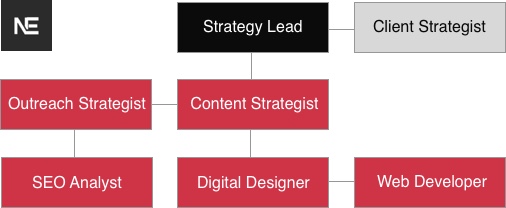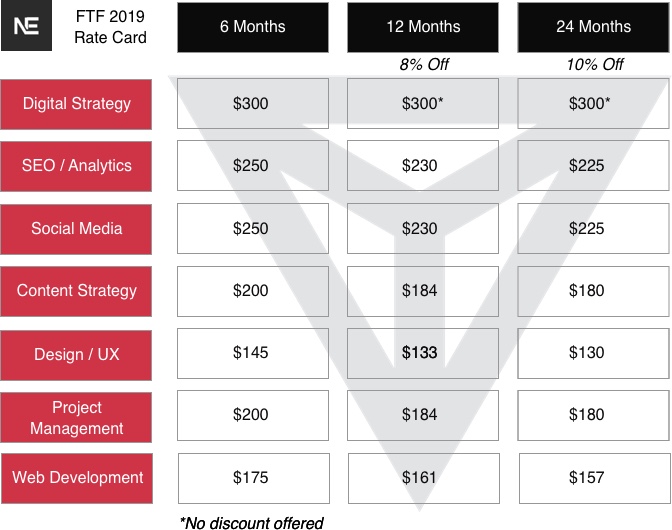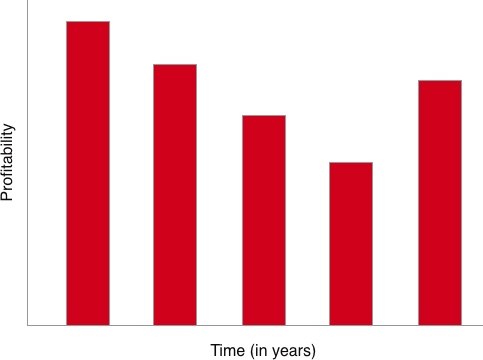For starters, we prefer to work with clients who are ready to bring on an agency.
But it’s also about the numbers, and yes I’m talking about profit.
The old saying goes;
Revenue is vanity, profit is sanity
Without profit, no business can survive.
Controlling your cost of goods sold (COGS) is one thing, but making sure you’re charging enough to cover both fixed and variable costs, while having enough cash leftover to cover additional operations (and to take care of your team; think things like 100% coverage of healthcare, unlimited PTO, a stocked kitchen, paid meals, and so on) all come from your profit bucket.
Breaking Down Our Cost Structure
FTF (originally founded as IFTF) has humble beginnings. We started out as a tax shelter for some personal consulting work and over the course of 5 years, grew into the talent powerhouse we are today. With this came quite a bit of evolution..
While our early engagements did often include some design, user experience, and web development to implement our strategies.. it wasn’t part of our founding identity.
Today that’s not the case at all.
We have built a team that has dedicated departments for: design, user experience, content strategy, web and application development, and of course, search.
What this means is our blended rate has changed dramatically.
Our average client project team looks something like this:

Where the Strategy Lead, is the Senior staff member on the project based on the focus of the engagement.
Then we have at least one member from all other FTF departments on every engagement to deliver what makes us different; performance informed digital marketing.
Our Current Rate Card
I’ve never understood agencies that play their rates close to the chest.
If anything, it means you wind up with more unqualified leads coming through your sales channels and clogging up the time of your business development staff.
So in full transparency, here’s our current rate card:

If you take these rates and apply them to our average retainer client’s project team, you can approach a blended rate.
What’s important to consider is the average weighting of each service item involved in our base retainer clients.
Which for a minimum retainer client, the 20 retainer hours tend to be broken out like this:
- Digital Strategy – 2 hours
- SEO (data collection, analysis, and strategy) – 8 hours
- Content Strategy – 5 hours
- Design – 2 hours
- Development (implementation advisory and support) – 1 hour
- Client Strategy (a blend of project management and account management, includes reporting) – 2 hours
Which shakes out to an average blended rate of $223.25.
What doesn’t get included, and is actually the largest cost for the agency, is all the additional time for meetings, both internal and external.
Our Minimum Retainer
For clients eager to partner with us, and get the time, energy, and attention of myself and my team – we require a minimum monthly retainer of $5,000, in exchange for an average of 20 hours (though we’re pretty quickly moving away from hours as the industries we’re in continue to evolve) for a period of 6 months.
This is where the $30,000 minimum engagement figure comes from.
We’ve found that to really move the needle, in a meaningful enough way to justify further investment – we prefer to have 6 months to design and then execute on our campaigns.
This isn’t to say that we don’t often come in and find glaring technical issues that can be resolved in month 1 (like the time we found a misplaced canonical tag that once removed had the source page shoot to position #5 for a commercial keyword with 130,000 searches/month the very next week), but these are more the exception than the rule.
Our Cost of Goods Sold
Here’s where most agency owners get it wrong.
Our COGS is not a straight-line breakdown of labor costs; you need to factor in all of the costs involved in delivering our service.
This means factoring in things like rent, utilities, software, equipment, etc… on top of labor costs.
My goal for any service-based business I am an owner in, is to establish and maintain at least a 30% net margin (net is the operative word there).
This means that with all costs considered, fixed and variable, at the end of the day there is always 30% of that average blended rate left in the bank.
This means with an average blended rate of $223.25 the company needs to retain $66.98 of every hour billed, or that the companies max cost to deliver a client an hour of billable work needs to be $156.27 or less.
FTF 2019 Labor Costs
| Position | Starting Salary | Hourly Cost | Payroll Tax | Operating Cost | Total Hourly Cost |
| SEO Analyst | $40,000 | $20.00 | $3.00 | $21.92 | $44.92 |
| SEO Strategist | $50,000 | $25.00 | $3.75 | $21.92 | $50.67 |
| Content Strategist | $50,000 | $25.00 | $3.75 | $21.92 | $50.67 |
| Digital Designer | $50,000 | $25.00 | $3.75 | $21.92 | $50.67 |
| Client Strategist | $50,000 | $25.00 | $3.75 | $21.92 | $50.67 |
| Outreach Strategist | $55,000 | $27.50 | $4.13 | $21.92 | $53.54 |
| Web Developer | $60,000 | $30.00 | $4.50 | $21.92 | $56.42 |
| Sr Client Strategist | $60,000 | $30.00 | $4.50 | $21.92 | $56.42 |
| Sr Content Strategist | $70,000 | $35.00 | $5.25 | $21.92 | $62.17 |
| Sr SEO Strategist | $80,000 | $40.00 | $6.00 | $21.92 | $67.92 |
| Sr Visual Strategist | $80,000 | $40.00 | $6.00 | $21.92 | $67.92 |
| Sr Web Developer | $100,000 | $50.00 | $7.00 | $21.92 | $79.42 |
| Director | $100,000 | $50.00 | $7.00 | $21.92 | $79.42 |
Here’s a projected scenario of what the agency COGS could look like for the average client’s project team:
Client Retainer COGS
| Service | Hours | Cost |
| Digital Strategy | 2 | $158.83 |
| SEO | 4 | $202.66 |
| Outreach | 4 | $214.16 |
| Content Strategy | 5 | $255.33 |
| Design | 2 | $101.33 |
| Development | 1 | $56.42 |
| Client Strategy | 2 | $101.33 |
| Internal Meetings | 6 | $2,386.68 |
| Client Meetings | 4 | $1,307.96 |
| Total | $3,474.73 |
| Avg Cost/Hour | $133.64 |
Here’s a plausible breakdown of the annual operating costs for a ~40 person digital agency:
Operating Costs
| Expense | Annual Cost | Cost/Hour |
| Rent | $60,000 | $0.86 |
| Utilities | $21,600 | $0.31 |
| Healthcare | $227,500 | $3.25 |
| Food | $14,400 | $0.21 |
| Equipment | $24,000 | $0.34 |
| Furniture | $25,000 | $0.36 |
| Insurance | $8,000 | $0.11 |
| Advertising | $100,000 | $1.43 |
| Content | $75,000 | $1.07 |
| Contractors | $479,262 | $6.85 |
| 3rd Party Software | $74,294 | $1.06 |
| Non-Billable Labor | $425,000 | $6.07 |
| Total | $1,534,056 | $21.92 |
As you can see in the above table, what this means is that our average overhead cost for all non-labor expenses is ~$22.00/hour.
Dialing This In
So if you do the math, to deliver 20 hours per month at $5,000 in fee’s to a client, it costs us (on average) $133.64 per hour, leaving us with $89.61.
Which means the average profit margin for a minimum retainer client (20 hours @ $5,000/month for 6 months) is $1,792.20, or 35.84%, which gives us a small margin of variability to deal with additional costs should they arise.
Shocked?
I bet you thought we were expensive (maybe even over-priced) when you saw our rate table above.
A very interesting thing to consider is back in 2014, when we were a team of 4 (me + 1 dev contractor + 2 apprentices) we charged $300/hour across the board, without any separate line items for varying services.
Our deal size was smaller back then, as was our client list (I think we had 5 clients that year?), but man were we profitable.
One major lesson I’ve learned watching an agency scale into having 50+ clients and ~40 employees is the profit margin curve is far from linear.
There actually seems to be a pretty massive dip when you hit a certain level of scale that it then takes years (and millions of dollars of operational investment) to recover from and point back up and to the right.
In our case it looked something like this:

What We’re Able to Deliver at This Level
Bringing this back to the core concept that profit is sanity, and what enables businesses to actually thrive and grow, our current rates (and minimum engagement) is designed to allow us to:
- Hire world class talent.
- Deliver significant growth in some of the most competitive vertical niches on the internet.
- Invest in building our own tools and expand our team’s capability range.
So with all things considered, we’re not actually expensive – but instead, we’re priced for efficiency at our level of impact and talent.
Are you an agency or consultant doing over $1 million per year in revenue?
If not, would you like to be?
I’m launching a private coaching program pretty soon, and if you’re ready to take your small agency or individual consulting business to the next level, you should check it out »
[…] Eubanks’ post ► https://nickeubanks.com/premium-agency-pricing/ *************************************** As an SEO consultant or freelancer, your income can be […]